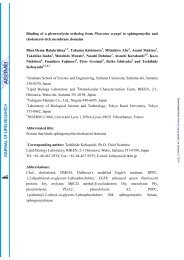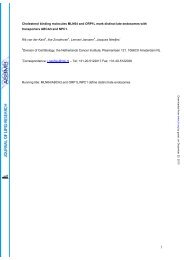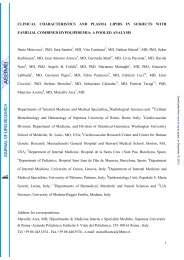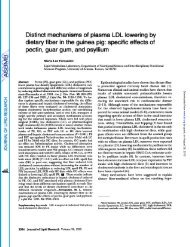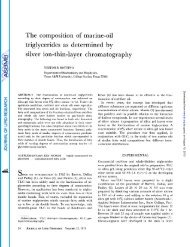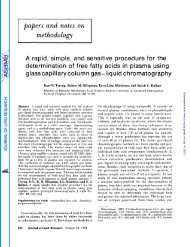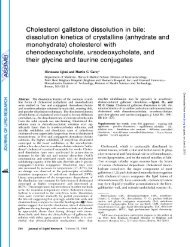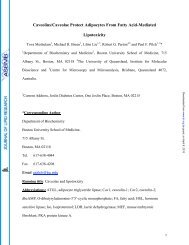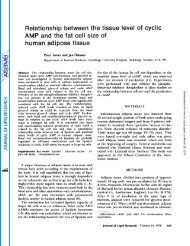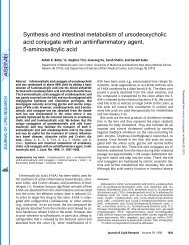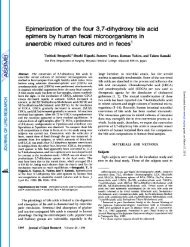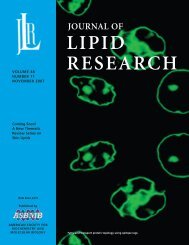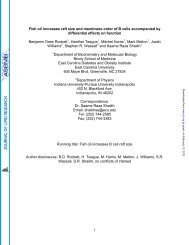Li pi d transfer protei n-catal yzed exc h an g e of cholesteryl ester ...
Li pi d transfer protei n-catal yzed exc h an g e of cholesteryl ester ...
Li pi d transfer protei n-catal yzed exc h an g e of cholesteryl ester ...
Create successful ePaper yourself
Turn your PDF publications into a flip-book with our unique Google optimized e-Paper software.
<strong>Li</strong> <strong>pi</strong> d <strong>tr<strong>an</strong>sfer</strong> <strong>protei</strong> n-<strong>catal</strong> <strong>yzed</strong> <strong>exc</strong> h <strong>an</strong> g e <strong>of</strong><br />
<strong>chol<strong>ester</strong>yl</strong> <strong>ester</strong> between high density lipo<strong>protei</strong>ns<br />
<strong>an</strong>d apoB-contain ing I i pop rote ins<br />
J. E. M. Groener' <strong>an</strong>d G. M. Kostner<br />
Institute <strong>of</strong> Medical Biochemistry, University <strong>of</strong> Graz, A-8010 Graz, Austria<br />
Abstract Low density lipo<strong>protei</strong>ns (LDL), lipo<strong>protei</strong>n<br />
(a)(Lp(a)), <strong>an</strong>d lipo<strong>protei</strong>n(a) after removal <strong>of</strong> the a-<strong>protei</strong>n<br />
(Lp(a-)) were compared with respect to their ability to accept<br />
<strong>chol<strong>ester</strong>yl</strong> <strong>ester</strong> from high density lipo<strong>protei</strong>ns (HDL). The in-<br />
cubations were performed at const<strong>an</strong>t concentrations <strong>of</strong> HDL<br />
<strong>an</strong>d various concentrations <strong>of</strong> either LDL, Lp(a), or Lp(a-).<br />
Lp(a) <strong>exc</strong>h<strong>an</strong>ged <strong>chol<strong>ester</strong>yl</strong> <strong>ester</strong> with HDL, but at a rate that<br />
was only 48.5 * 3.8% <strong>of</strong> the <strong>exc</strong>h<strong>an</strong>ge rate found in the presence<br />
<strong>of</strong> autologous LDL. Cleavage <strong>of</strong> the apo(a) from Lp(a) resulted<br />
in Lp(a-), <strong>an</strong> LDL-like particle, with characteristics <strong>of</strong><br />
<strong>chol<strong>ester</strong>yl</strong> <strong>ester</strong> <strong>exc</strong>h<strong>an</strong>ge very similar to LDL.-Groener,<br />
J. E. M., <strong>an</strong>d G. M. Kostner. <strong>Li</strong><strong>pi</strong>d <strong>tr<strong>an</strong>sfer</strong> <strong>protei</strong>n-<strong>catal</strong><strong>yzed</strong><br />
<strong>exc</strong>h<strong>an</strong>ge <strong>of</strong> <strong>chol<strong>ester</strong>yl</strong> <strong>ester</strong> between high density lipo<strong>protei</strong>ns<br />
<strong>an</strong>d apoB-containing lipo<strong>protei</strong>ns. J. <strong>Li</strong><strong>pi</strong>d Res. 1987. 28:<br />
1053 - 1056.<br />
Supplementary key words <strong>chol<strong>ester</strong>yl</strong> <strong>ester</strong> <strong>tr<strong>an</strong>sfer</strong>/<strong>exc</strong>h<strong>an</strong>ge low<br />
density lipo<strong>protei</strong>ns lipo<strong>protei</strong>n(a) lipo<strong>protei</strong>n(a-)<br />
Chol<strong>ester</strong>yl <strong>ester</strong>s are components <strong>of</strong> all the major lipo<strong>protei</strong>n<br />
classes <strong>an</strong>d are localized predomin<strong>an</strong>tly within the<br />
hydrophobic core <strong>of</strong> these particles. In hum<strong>an</strong> plasma,<br />
<strong>chol<strong>ester</strong>yl</strong> <strong>ester</strong>s are synthesized mainly in HDL3 by the<br />
action <strong>of</strong> 1ecithin:chol<strong>ester</strong>ol acyl<strong>tr<strong>an</strong>sfer</strong>ase (LCAT) (1)<br />
<strong>an</strong>d subsequently <strong>tr<strong>an</strong>sfer</strong>red to or <strong>exc</strong>h<strong>an</strong>ged between<br />
very low density lipo<strong>protei</strong>ns (VLDL), low density lipo<strong>protei</strong>ns<br />
(LDL), <strong>an</strong>d high density lipo<strong>protei</strong>ns (HDL).<br />
This process is <strong>catal</strong><strong>yzed</strong> by li<strong>pi</strong>d <strong>tr<strong>an</strong>sfer</strong> <strong>protei</strong>ns (LTPs)<br />
(2-5).<br />
Lp(a), first described by Berg (6), is a lipo<strong>protei</strong>n present<br />
in most hum<strong>an</strong> plasmas in concentrations r<strong>an</strong>ging<br />
between less th<strong>an</strong> 1 <strong>an</strong>d more th<strong>an</strong> 100 mg/dl. Lp(a) is <strong>of</strong><br />
particular interest since it seems to be <strong>an</strong> independent risk<br />
factor in atherogenesis. Lp(a) is similar to LDL with<br />
respect to m<strong>an</strong>y <strong>of</strong> its physical <strong>an</strong>d chemical properties.<br />
The li<strong>pi</strong>d composition is almost identical with that <strong>of</strong><br />
LDL. The main apo<strong>protei</strong>n in both lipo<strong>protei</strong>ns is apoB.<br />
In Lp(a), however, <strong>an</strong> additional specific <strong>protei</strong>n, apo(a),<br />
is present, which is bound to apoB by disulfide linkage<br />
(7-9). At present, the sites(s) <strong>of</strong> Lp(a) synthesis <strong>an</strong>d catabolism<br />
are not completely clear. Lp(a) does not seem to<br />
be a metabolic product <strong>of</strong> other apoB-containing lipopro-<br />
teins <strong>an</strong>d it seems to be synthesized as a separate lipopro-<br />
tein (10, 11). Contradictory results have been reported as<br />
to whether Lp(a) may be cleared by the LDL receptor<br />
pathway (12-14).<br />
No information is available on the characteristics <strong>of</strong><br />
Lp(a) with respect to the capability <strong>of</strong> Lp(a) to tr<strong>an</strong>s-<br />
fed<strong>exc</strong>h<strong>an</strong>ge <strong>chol<strong>ester</strong>yl</strong> <strong>ester</strong> (CE) with HDL.<br />
In this study, we have compared the characteristics <strong>of</strong><br />
the <strong>chol<strong>ester</strong>yl</strong> <strong>ester</strong> <strong>exc</strong>h<strong>an</strong>ge between HDL <strong>an</strong>d LDL,<br />
Lp(a), <strong>an</strong>d Lp(a-).<br />
METHODS<br />
Isolation <strong>of</strong> lipo<strong>protei</strong>ns: LDL, Lp(a), Lp(a-), <strong>an</strong>d<br />
HDL<br />
Fresh hum<strong>an</strong> plasma was screened for Lp(a) im-<br />
munoreactivity by immunodiffusion (15). Strongly Lp(a)-<br />
positive plasmas were collected in 1 mM EDTA containing<br />
0.01% sodium azide, <strong>an</strong>d immediately subjected to ultra-<br />
centrifugation. Lp(a) was isolated by ultracentrifugation<br />
<strong>of</strong> the plasmas between d 1.060 <strong>an</strong>d 1.125 g/ml, followed<br />
by size <strong>exc</strong>lusion chromatography (10, 11). The fractions<br />
containing apo(a) were combined <strong>an</strong>d concentrated by<br />
pressure dialysis.<br />
Part <strong>of</strong> the Lp(a) was reduced with dithiothreitol (DTT)<br />
as described by Armstrong, Walli, <strong>an</strong>d Seidel (16). DTT<br />
was freshly added, 10 hmol <strong>of</strong> DTT/ mg <strong>of</strong> <strong>protei</strong>n, to the<br />
Abbreviations: VLDL, very low density lipo<strong>protei</strong>ns; LDL, low den-<br />
sity lipo<strong>protei</strong>ns; HDL, high density lipo<strong>protei</strong>ns; Lp(a), lipo<strong>protei</strong>n(a);<br />
Lp(a-), lipo<strong>protei</strong>n(a) after removal <strong>of</strong> the a-<strong>protei</strong>n; LTP, li<strong>pi</strong>d <strong>tr<strong>an</strong>sfer</strong><br />
<strong>protei</strong>n; CETP, <strong>chol<strong>ester</strong>yl</strong> <strong>ester</strong> <strong>tr<strong>an</strong>sfer</strong> <strong>protei</strong>n; LCAT, lecithin:<br />
chol<strong>ester</strong>ol acyl<strong>tr<strong>an</strong>sfer</strong>ase; CE, <strong>chol<strong>ester</strong>yl</strong> <strong>ester</strong>; DTT, dithiothreitol.<br />
'To whom correspondence should be addressed at present address:<br />
Department <strong>of</strong> Biochemistry I, Erasmus University Rotterdam, 3500<br />
DR Rotterdam, The Netherl<strong>an</strong>ds.<br />
Journal <strong>of</strong> <strong>Li</strong><strong>pi</strong>d Research Volume 28, 1987 1053<br />
Downloaded from<br />
www.jlr.org<br />
by guest, on February 18, 2013
Lp(a) solution <strong>an</strong>d the solution was incubated at 37OC for<br />
3 hr. After the incubation the mixture was applied to a<br />
heparin-Sepharose column (20 x 1.5 cm), equilibrated<br />
with 10 mM Tris-HC1, 50 mM NaCl, 1 mM, EDTA, <strong>an</strong>d<br />
0.02% NaN3 (pH 7.6). Apo(a) eluted first, followed by<br />
DTT. After increasing the salt concentration to 0.5 mM<br />
NaCl, Lp(a-) eluted from the column. The Lp(a-) was<br />
further dial<strong>yzed</strong> <strong>an</strong>d concentrated by pressure dialysis.<br />
LDL <strong>an</strong>d HDL were isolated by ultracentrifugation <strong>of</strong><br />
plasma at densities between 1.020 <strong>an</strong>d 1.060 g/ml <strong>an</strong>d<br />
1.070 <strong>an</strong>d 1.210 g/ml, respectively. Both lipo<strong>protei</strong>ns were<br />
washed once at the appropriate densities. All lipo<strong>protei</strong>ns<br />
were dial<strong>yzed</strong> against 10 mM Tris-HC1, 150 mM NaCI, 1<br />
mM EDTA, 0.01% NaN3 (pH 7.4).<br />
Purification <strong>of</strong> <strong>chol<strong>ester</strong>yl</strong> <strong>ester</strong> <strong>tr<strong>an</strong>sfer</strong> <strong>protei</strong>n<br />
(CETP)<br />
CETP was partially purified from the d> 1.18 g/ml<br />
supernate <strong>of</strong> hum<strong>an</strong> plasma as described by Pattnaik et al.<br />
(17). The supernate was chromatographed on a Phenyl-<br />
sepharose CL 4B column (Pharmacia, Fine Chemicals),<br />
followed by cation <strong>exc</strong>h<strong>an</strong>ge chromatography on a CM<br />
cellulose column (Whatm<strong>an</strong> CM-52). The specific activi-<br />
ty <strong>of</strong> the partially purified CETP fraction was increased<br />
800-fold in relation to plasma. The partially purified<br />
CETP preparation was free <strong>of</strong> LCAT. LCAT activity was<br />
assayed as described by Glomset <strong>an</strong>d Wright (18). CETP<br />
activity in the purification procedure was measured bet-<br />
ween ['*C-labeled CEILDL <strong>an</strong>d HDL as described before<br />
(19).<br />
Chol<strong>ester</strong>yl <strong>ester</strong> <strong>exc</strong>h<strong>an</strong>ge between HDL <strong>an</strong>d LDL,<br />
Lp(a), <strong>an</strong>d Lp(a-)<br />
HDL was labeled with [ **C]<strong>chol<strong>ester</strong>yl</strong> oleate (Amer-<br />
sham It.) by a modification (19) <strong>of</strong> the li<strong>pi</strong>d dispersion<br />
technique <strong>of</strong> Morton <strong>an</strong>d Zilversmit (20). -Labeled<br />
HDL (150 nmol <strong>of</strong> <strong>chol<strong>ester</strong>yl</strong> <strong>ester</strong>, 10,000 cpm) was in-<br />
cubated with various amounts <strong>of</strong> either LDL, Lp(a), or<br />
Lp(a-) in 50 mM phosphate buffer <strong>an</strong>d 2% BSA in the<br />
presence <strong>of</strong> partially purified CETP for 2 hr at 37OC. The<br />
amounts <strong>of</strong> LDL, Lp(a), <strong>an</strong>d Lp(a-) were adjusted to<br />
equivalent concentrations <strong>of</strong> CE. Total volume was 0.7<br />
ml. Since LCAT was not present in the CETP prepara-<br />
tion, as checked by the method <strong>of</strong> Glomset <strong>an</strong>d Wright<br />
(18), no inhibitor for this enzyme was added. After in-<br />
cubation the tubes were placed on ice <strong>an</strong>d LDL, Lp(a),<br />
<strong>an</strong>d Lp(a-) were preci<strong>pi</strong>tated, after the addition <strong>of</strong> 2 pmol<br />
<strong>of</strong> LDL-total chol<strong>ester</strong>ol, with 0.1 vol <strong>of</strong> 2% dextr<strong>an</strong><br />
sulfate-2 M MgC12 (1:l). The preci<strong>pi</strong>tate was washed once<br />
by resuspension in 150 mM NaCl <strong>an</strong>d preci<strong>pi</strong>tated again.<br />
Finally the preci<strong>pi</strong>tate was solubilized in 1 ml <strong>of</strong> 10%<br />
NaCl <strong>an</strong>d the radioactivity was measured by liquid scin-<br />
tillation counting (LKB 1219 Rackbeta). In all experi-<br />
ments control incubations in the absence <strong>of</strong> CETP were<br />
performed, <strong>an</strong>d the measured radioactivity in these in-<br />
cubations was subtracted as a bl<strong>an</strong>k.<br />
1054 Journal <strong>of</strong> <strong>Li</strong><strong>pi</strong>d Research Volume 28, 1987<br />
Mass <strong>tr<strong>an</strong>sfer</strong> between HDL <strong>an</strong>d LDL, Lp(a), or<br />
Lp(a-) was estimated by chemical <strong>an</strong>alysis <strong>of</strong> all fraci ions<br />
after incubation. CETP activity was calculated according<br />
to Barter <strong>an</strong>d Jones (21) as previously outlined (19).<br />
<strong>Li</strong><strong>pi</strong>d <strong>an</strong>d lipo<strong>protei</strong>n <strong>an</strong>alysis<br />
Total chol<strong>ester</strong>ol, free chol<strong>ester</strong>ol, triglycerides, <strong>an</strong>d<br />
phospholi<strong>pi</strong>ds were measured by enzymatic methods. The<br />
following kits were used: total chol<strong>ester</strong>ol, kit number 237<br />
574 (Boehringer); free chol<strong>ester</strong>ol, kit number 14106<br />
(Merck); triglycerides, kit number 612318 (BioMerieux);<br />
<strong>an</strong>d phospholi<strong>pi</strong>ds, kit number 61410 (BioMerieux).<br />
Chol<strong>ester</strong>yl <strong>ester</strong> was calculated as the difference between<br />
total chol<strong>ester</strong>ol <strong>an</strong>d free chol<strong>ester</strong>ol. Protein was deter-<br />
mined according to the method <strong>of</strong> Lowry et al. (22). The<br />
amount <strong>of</strong> apoB in Lp(a) <strong>an</strong>d Lp(a-) was estimated by<br />
rocket electrophoresis (23).<br />
RESULTS<br />
LDL, Lp(a), <strong>an</strong>d Lp(a-) were isolated from the same<br />
batch <strong>of</strong> plasma. The fractions were assayed for <strong>protei</strong>n,<br />
<strong>chol<strong>ester</strong>yl</strong> <strong>ester</strong>, free chol<strong>ester</strong>ol, phospholi<strong>pi</strong>ds, trigly-<br />
cerides, <strong>an</strong>d apoB. The li<strong>pi</strong>d values are expressed as<br />
weight percentage <strong>of</strong> the total lipo<strong>protei</strong>n mass. In two ex-<br />
periments, LDL <strong>an</strong>d Lp(a) were investigated; in two other<br />
experiments, LDL, Lp(a), <strong>an</strong>d Lp(a-) were investigated.<br />
The results are presented in Table 1. Lp(a) differed from<br />
LDL in its higher <strong>protei</strong>n content <strong>an</strong>d its slightly lower<br />
content <strong>of</strong> <strong>chol<strong>ester</strong>yl</strong> <strong>ester</strong>. Lp(a-) <strong>an</strong>d LDL had similar<br />
li<strong>pi</strong>d <strong>an</strong>d <strong>protei</strong>n compositions. Measurements <strong>of</strong> apoB,<br />
by rocket electrophoresis, in LDL, Lp(a), <strong>an</strong>d Lp(a-)<br />
showed that in LDL <strong>an</strong>d in Lp(a-) 95% <strong>of</strong> the total pro-<br />
tein was apoB, whereas in Lp(a) this value was 65%.<br />
Since no mass <strong>tr<strong>an</strong>sfer</strong> was found between HDL <strong>an</strong>d<br />
LDL, Lp(a), or Lp(a-) during the 2-hr incubation, the<br />
data are presented as <strong>exc</strong>h<strong>an</strong>ge rates. Exch<strong>an</strong>ge <strong>of</strong> CE<br />
between HDL <strong>an</strong>d LDL, Lp(a), <strong>an</strong>d Lp(a-) was esti-<br />
mated in incubations in which the amount <strong>of</strong> HDL (150<br />
nmol <strong>of</strong> <strong>chol<strong>ester</strong>yl</strong> <strong>ester</strong>) was const<strong>an</strong>t <strong>an</strong>d the amount <strong>of</strong><br />
LDL, Lp(a), <strong>an</strong>d Lp(a-) was between 50 <strong>an</strong>d 650 nmol<br />
<strong>of</strong> <strong>chol<strong>ester</strong>yl</strong> <strong>ester</strong>. Incubations were performed for '2 hr.<br />
In previous experiments we ascertained that the <strong>exc</strong>h<strong>an</strong>ge<br />
process was linear for at least 4 hr. Fig. 1 shows the results<br />
<strong>of</strong> such <strong>an</strong> experiment. Over the whole concentration<br />
r<strong>an</strong>ge CETP activity was the lowest in incubations in<br />
which Lp(a) served as acceptor for CE from HDL.<br />
However, in the presence <strong>of</strong> Lp(a-) as acceptor for CE,<br />
the CETP activity was quite similar to that <strong>of</strong> LDL.<br />
We compared the CETP activity <strong>of</strong> the incubations in<br />
the presence <strong>of</strong> LDL with the incubations in the presence<br />
<strong>of</strong> Lp(a) or Lp(a-) at four different concentrations. The<br />
CETP activity in the presence <strong>of</strong> LDL was taken as 100%.<br />
The CETP activity in the presence <strong>of</strong> Lp(a) <strong>an</strong>d Lp(a-)<br />
is expressed as <strong>of</strong> the <strong>tr<strong>an</strong>sfer</strong> activity in the presence<br />
Downloaded from<br />
www.jlr.org<br />
by guest, on February 18, 2013
TABLE 1. Comparison <strong>of</strong> the composition <strong>of</strong> LDL, '-p(a), <strong>an</strong>d Lp(a-)<br />
Sample Free Choleaterol Chol<strong>ester</strong>yl Ester Triglycerides Phospholi<strong>pi</strong>ds Protein<br />
LDL (n = 4) 9.2 i 0.4" 40.3 + 1.7 4.5 + 1.6 20.4 * 0.6 25.6 i 2.0<br />
Lp(4 (n - 4) 8.8 f 0.3 37.8 f 2.7 4.0 + 0.6 20.2 * 0.8 29.2 * 2.5<br />
Lp(a-) (n = 2) 9.0 * 0.2 40.6 f 1.5 5.6 i 0.6 20.5 f 0.5 24.4 f 1.5<br />
'Values represent me<strong>an</strong>s i SD <strong>of</strong> n observations.<br />
<strong>of</strong> LDL. There were no signific<strong>an</strong>t differences among the<br />
four concentrations. For all concentrations the CETP ac-<br />
tivity in the presence <strong>of</strong> Lp(a) was 48.5 * 3.8%, <strong>an</strong>d in the<br />
presence <strong>of</strong> Lp(a-) 85.8*5.7% <strong>of</strong> the CETP activity<br />
found in the presence <strong>of</strong> LDL.<br />
DISCUSSION<br />
Krempler et al. (10) suggested that Lp(a) is synthesized by<br />
the liver with no apparent precursor. Since, on the other<br />
h<strong>an</strong>d, the fatty acid composition <strong>of</strong> CE in Lp(a) <strong>an</strong>d LDL<br />
is almost identical, <strong>an</strong>d LCAT is not active on Lp(a) (E<br />
ILDL], [Lp(a)], [Lp(a-)l (nmolcs CElincubation)<br />
Fig. 1. Chol<strong>ester</strong>yl <strong>ester</strong> <strong>tr<strong>an</strong>sfer</strong> <strong>protei</strong>n (CETP) activity between<br />
HDL <strong>an</strong>d LDL, Lp(a), or Lp(a-) in one characteristic experiment.<br />
[''C]<strong>chol<strong>ester</strong>yl</strong> oleate-labeled HDL (150 nmol <strong>of</strong> CE) was incubated for<br />
2 hr at 37OC with either LDL, Lp(a), or Lp(a-) in the presence <strong>of</strong> partially<br />
purified CETP. The <strong>exc</strong>h<strong>an</strong>ge <strong>of</strong> CE was measured as described<br />
P<br />
Krempler <strong>an</strong>d G. M. Kostner, unpublished results), CE<br />
<strong>tr<strong>an</strong>sfer</strong>/<strong>exc</strong>h<strong>an</strong>ge is the only process in the plasma that<br />
c<strong>an</strong> yield such a particle.<br />
The present study shows that Lp(a) is <strong>an</strong> acceptor <strong>of</strong><br />
CE from HDL. This process c<strong>an</strong> explain the similar fatty<br />
acid composition <strong>of</strong> <strong>chol<strong>ester</strong>yl</strong> <strong>ester</strong> in Lp(a) <strong>an</strong>d in other<br />
lipo<strong>protei</strong>ns. No mass <strong>tr<strong>an</strong>sfer</strong> was found under the conditions<br />
chosen for our study. This might be due to the fact<br />
that in fasted plasma <strong>an</strong> equilibrium exists between the<br />
<strong>chol<strong>ester</strong>yl</strong> <strong>ester</strong> in HDL <strong>an</strong>d Lp(a) as has been found for<br />
HDL <strong>an</strong>d LDL (24). Noticable is the lower <strong>exc</strong>h<strong>an</strong>ge activity<br />
<strong>of</strong> Lp(a) as compared to autologous LDL. However,<br />
reduction <strong>of</strong> Lp(a), yielding <strong>an</strong> LDL-like particle, results<br />
in <strong>an</strong> improvement <strong>of</strong> the particle as acceptor for CE,<br />
reaching up to 86% <strong>of</strong> the activity measured for LDL.<br />
In a recent study, Eisenberg (25) noticed a difference in<br />
the rate <strong>of</strong> <strong>chol<strong>ester</strong>yl</strong> <strong>ester</strong> <strong>exc</strong>h<strong>an</strong>ge <strong>an</strong>d <strong>tr<strong>an</strong>sfer</strong> between<br />
HDL <strong>an</strong>d VLDL <strong>an</strong>d LDL <strong>of</strong> different sizes. Based on<br />
this, Eisenberg suggested that li<strong>pi</strong>d <strong>tr<strong>an</strong>sfer</strong> is a surface<br />
reaction <strong>an</strong>d that a large surface area positively influences<br />
the amount <strong>of</strong> <strong>tr<strong>an</strong>sfer</strong>red molecules. Whether mass<br />
<strong>tr<strong>an</strong>sfer</strong> occurs is more dependent on the composition <strong>of</strong><br />
the lipo<strong>protei</strong>n core. Lp(a) is a larger particle th<strong>an</strong> LDL<br />
(7). Recent studies show that there is only a slight difference<br />
in the moles <strong>of</strong> CE per particle (26). LDL, Lp(a),<br />
<strong>an</strong>d Lp(a-) contained almost equal amounts <strong>of</strong> CE per<br />
particle (1600- 1900 nmol). Therefore, in our experiments<br />
in which the incubations were adjusted to equivalent concentrations<br />
<strong>of</strong> CE, <strong>an</strong> approximately equal number <strong>of</strong><br />
particles was present in the incubations. Since one would<br />
expect a greater probability <strong>of</strong> <strong>exc</strong>h<strong>an</strong>ge when the surface<br />
is larger (25), the approximately 50% lower <strong>exc</strong>h<strong>an</strong>ge activity<br />
was surprising. Two possible expl<strong>an</strong>ations c<strong>an</strong> be envisaged.<br />
First, the apo(a) <strong>protei</strong>n is located on the surface<br />
<strong>of</strong> the particle in such a way that the actual surface that<br />
is available for the CE <strong>exc</strong>h<strong>an</strong>ge is much smaller th<strong>an</strong> for<br />
the comparable LDL particle. Second, Lp(a) binds CETP<br />
to a much lower extent th<strong>an</strong> LDL does. Steric hindr<strong>an</strong>ce<br />
with respect to the <strong>exc</strong>h<strong>an</strong>ge process may occur. This<br />
assumption is in line with the findings in the present<br />
work* where <strong>exc</strong>h<strong>an</strong>ge activity increases after Of<br />
apo(a). The finding in this study supports a previous view<br />
that LDL <strong>an</strong>d L ~(~-) behave similarly. A~~~~~~~~ et al.<br />
(16) the high<br />
Of LDL <strong>an</strong>d Lp(a-) with<br />
in Methods. Results represent me<strong>an</strong>s i SD <strong>of</strong> three incubations. respect to their cellular uptake by the LDL receptor in<br />
Groencr <strong>an</strong>d Kostner <strong>Li</strong><strong>pi</strong>d <strong>tr<strong>an</strong>sfer</strong> <strong>protei</strong>n-<strong>catal</strong><strong>yzed</strong> <strong>exc</strong>h<strong>an</strong>ge <strong>of</strong> <strong>chol<strong>ester</strong>yl</strong> <strong>ester</strong> 1055<br />
Downloaded from<br />
www.jlr.org<br />
by guest, on February 18, 2013
cultured hum<strong>an</strong> fibroblasts. The present work shows that<br />
LDL <strong>an</strong>d Lp(a-) are almost identical with respect to their<br />
ability to accept <strong>chol<strong>ester</strong>yl</strong> <strong>ester</strong> from HDL. I<br />
We would like to th<strong>an</strong>k Dr. A. Gries for estimating the apoB con-<br />
tent in LDL, Lp(a), <strong>an</strong>d Lp(a-), <strong>an</strong>d H. Zeiler for the technical<br />
assist<strong>an</strong>ce. This work was supported by a gr<strong>an</strong>t from the Aus-<br />
tri<strong>an</strong> Research Foundation, gr<strong>an</strong>t No. P5144, <strong>an</strong>d from the Aus-<br />
tri<strong>an</strong> Nationalb<strong>an</strong>k (gr<strong>an</strong>t No. 2663).<br />
M<strong>an</strong>wmpt receiued I1 December 1986 <strong>an</strong>d in revisedform 25 March 1987.<br />
1.<br />
2.<br />
3.<br />
4.<br />
5.<br />
6.<br />
7.<br />
8.<br />
9.<br />
10.<br />
11.<br />
12.<br />
REFERENCES<br />
Glomset, J. A., <strong>an</strong>d K. R. Norum. 1973. The metabolic role<br />
<strong>of</strong> 1ecithin:chol<strong>ester</strong>ol acyl<strong>tr<strong>an</strong>sfer</strong>ase. Perspectives from<br />
pathology. Adv. <strong>Li</strong><strong>pi</strong>d Res. 11: 1-65.<br />
Zilversmit, D. B., L. B. Hughes, <strong>an</strong>d J. Balmer. 1975. Stimulation<br />
<strong>of</strong> chol<strong>ester</strong>ol <strong>ester</strong> <strong>exc</strong>h<strong>an</strong>ge by lipo<strong>protei</strong>n-free<br />
plasma. Biochim. Biophys. Acta. 409: 393-398.<br />
Fielding, P. E., <strong>an</strong>d C. J. Fielding. 1980. Chol<strong>ester</strong>yl <strong>ester</strong><br />
<strong>tr<strong>an</strong>sfer</strong> complex in hum<strong>an</strong> plasma. Proc. Natl. Acad. Sci.<br />
USA. 77: 3327-3330.<br />
Ha, Y. C., G. D. Calvert, G. H. McIntosh, <strong>an</strong>d P. J. Barter.<br />
1981. A physiologic role for the <strong>ester</strong>ified chol<strong>ester</strong>ol<br />
<strong>tr<strong>an</strong>sfer</strong> <strong>protei</strong>n: in vivo studies in rabbits <strong>an</strong>d <strong>pi</strong>gs. Metabolism.<br />
30: 380-383.<br />
Tall, A. R. 1986. Plasma li<strong>pi</strong>d <strong>tr<strong>an</strong>sfer</strong> <strong>protei</strong>ns. J. <strong>Li</strong><strong>pi</strong>d Res.<br />
27: 361-367.<br />
Berg, K. 1963. A new serum type system in m<strong>an</strong> - the Lp<br />
system. Acta Pathol. Micmbiol. Sc<strong>an</strong>d. 59: 369-382.<br />
Kostner, G. M. 1983. Apolipo<strong>protei</strong>ns <strong>an</strong>d lipo<strong>protei</strong>ns <strong>of</strong><br />
hum<strong>an</strong> serum. Adv. <strong>Li</strong><strong>pi</strong>d Res. 20: 1-43.<br />
Gaubatz, J. W., C. Heidem<strong>an</strong>, A. M. Gotto, J. D. Morisett,<br />
<strong>an</strong>d G. H. Dahlen. 1983. Hum<strong>an</strong> plasma lipo<strong>protei</strong>n(a).<br />
Structural properties. J. Biol. Chem. 258: 4582-4589.<br />
Uterm<strong>an</strong>n, G., <strong>an</strong>d W. Weber. 1983. Protein composition <strong>of</strong><br />
Lp(a) lipo<strong>protei</strong>n from hum<strong>an</strong> plasma. FEBS Lett. 154:<br />
357-361.<br />
Krempler, F., G. M. Kostner, K. Bolz<strong>an</strong>o, <strong>an</strong>d F. S<strong>an</strong>dh<strong>of</strong>er.<br />
1979. <strong>Li</strong>po<strong>protei</strong>n(a) is not a metabolic product <strong>of</strong><br />
other lipo<strong>protei</strong>ns containing apolipo<strong>protei</strong>n B. Biochim.<br />
Biophys. Acta. 575: 63-70.<br />
Krempler, E, G. M. Kostner, K. Bolz<strong>an</strong>o, <strong>an</strong>d F. S<strong>an</strong>dh<strong>of</strong>er.<br />
1980. Turnover <strong>of</strong> lipo<strong>protei</strong>n(a) in m<strong>an</strong>. J. Clin. Invest.<br />
65: 1483-1490.<br />
Maartm<strong>an</strong>n-Moe, K., <strong>an</strong>d K. Berg. 1981. Lp(a) lipo<strong>protei</strong>n<br />
1056 Journal <strong>of</strong> <strong>Li</strong><strong>pi</strong>d Research Volume 28, 1987<br />
enters cultured fibroblasts independently <strong>of</strong> the pl.isma<br />
membr<strong>an</strong>e low density lipo<strong>protei</strong>n receptor. Clin. Genet 20:<br />
352-362.<br />
13 Havekes, L., B. J. Vermeer, T. Brugm<strong>an</strong>, <strong>an</strong>d J. Elnels.<br />
1981. Binding <strong>of</strong> Lp(a) to the low density lipo<strong>protei</strong>n rrceptor<br />
<strong>of</strong> hum<strong>an</strong> fibroblasts. FEBS Lett. 132: 169-173.<br />
14. Floren, C. H., J. J. Albers, <strong>an</strong>d E. L. Bierm<strong>an</strong>. 1981. Uptake<br />
<strong>of</strong> Lp(a) lipo<strong>protei</strong>n by cultured fibroblasts. Biothem.<br />
Bioplrys. Res. Commun. 102: 636-639.<br />
15. Kostner, G. M., J. R. Patsch, S. Sailer, H. Braunsteiner,<br />
<strong>an</strong>d A. Holasek. 1974. Polypeptide distribution <strong>of</strong> the main<br />
lipo<strong>protei</strong>n density classes separated from hum<strong>an</strong> plasma<br />
by rate zonal ultracentrifugation. EUK J Biochem. 45:<br />
61-621.<br />
16. Armstrong, V. W., A. K. Walli, <strong>an</strong>d D. Seidel. 1985. Isolation,<br />
characterization, <strong>an</strong>d uptake in hum<strong>an</strong> fibroblasts <strong>of</strong><br />
<strong>an</strong> apo(a)-free lipo<strong>protei</strong>n obtained on reduction <strong>of</strong> lipo<strong>protei</strong>n(a).<br />
J <strong>Li</strong><strong>pi</strong>d Res. 26: 1314-1323.<br />
17. Pattnaik, N. H., A. Montes, L. B. Hughes, <strong>an</strong>d D. B.<br />
Zilversmit. 1978. Chol<strong>ester</strong>yl <strong>ester</strong> <strong>exc</strong>h<strong>an</strong>ge <strong>protei</strong>n in hum<strong>an</strong><br />
plasma: isolation <strong>an</strong>d characterization. Biochim.<br />
Biophys. Acta. 530: 428-438.<br />
18. Glomset, A. J., <strong>an</strong>d J. L. Wright. 1964. Some properties <strong>of</strong><br />
a chol<strong>ester</strong>ol <strong>ester</strong>ifying enzyme in hum<strong>an</strong> plasma. Biochim.<br />
Biophys. Acta. 89: 266-276.<br />
19. Groener, J. E. M., R. W. Pelton, <strong>an</strong>d G. M. Kostner. 1986.<br />
Improved estimation <strong>of</strong> <strong>chol<strong>ester</strong>yl</strong> <strong>ester</strong> tr<strong>an</strong>sfed<strong>exc</strong>h<strong>an</strong>ge<br />
activity in serum or plasma. Clin. Chem. 32: 283-286.<br />
20. Morton, R. E., <strong>an</strong>d D. B. Zilversmit. 1981. A plasma inhibitor<br />
<strong>of</strong> triglyceride <strong>an</strong>d <strong>chol<strong>ester</strong>yl</strong> <strong>ester</strong> <strong>tr<strong>an</strong>sfer</strong> activities. J<br />
Biol. Chem. 256: 11992-11995.<br />
21. Barter, P. J., <strong>an</strong>d M. E. Jones. 1979. Rate <strong>of</strong> <strong>exc</strong>h<strong>an</strong>ge <strong>of</strong><br />
<strong>ester</strong>ified chol<strong>ester</strong>ol between hum<strong>an</strong> plasma low <strong>an</strong>d high<br />
density lipo<strong>protei</strong>ns. Atherosclemsis. 34: 67-74.<br />
22. Lowry, 0. H., N. J. Rosebrough, A. L. Farr, <strong>an</strong>d R. J. R<strong>an</strong>dall.<br />
1951. Protein measurement with the Folin phenol reagent.<br />
J Biol. Chem. 193: 265-275.<br />
23. Laurell, C. B. 1972. Electroimmunoassay. Sc<strong>an</strong>d. J Clin.<br />
Lab. Invest. 29 Suppl. 124: 21-37.<br />
24. Barter, P. J., <strong>an</strong>d J. I. Lally. 1979. In vitro <strong>exc</strong>h<strong>an</strong>ges <strong>of</strong> <strong>ester</strong>ified<br />
chol<strong>ester</strong>ol between serum lipo<strong>protei</strong>n fractions:<br />
studies <strong>of</strong> hum<strong>an</strong>s <strong>an</strong>d rabbits. Metabolism. 28: 230-236.<br />
25. Eisenberg, S. 1985. Preferential enrichment <strong>of</strong> large-sized<br />
very low density lipo<strong>protei</strong>n populations with <strong>tr<strong>an</strong>sfer</strong>red<br />
<strong>chol<strong>ester</strong>yl</strong> <strong>ester</strong>s. J. <strong>Li</strong><strong>pi</strong>d Res. 26: 487-494.<br />
26. Fless, G. M., M. E. ZumMallen, <strong>an</strong>d A. M. Sc<strong>an</strong>u. 1986.<br />
Physicochemical properties <strong>of</strong> apolipo<strong>protei</strong>n(a) <strong>an</strong>d lipo<strong>protei</strong>n(a-)<br />
derived from the dissociation <strong>of</strong> hum<strong>an</strong> plasma<br />
lipo<strong>protei</strong>n(a). J Biol. Chem. 261: 8712-8718.<br />
Downloaded from<br />
www.jlr.org<br />
by guest, on February 18, 2013



